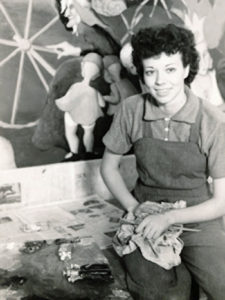
Bernice Cross
*Bernice Cross was born on this date in 1912. She was a Black artist and art instructor based in Washington, D.C., for most of her professional career.
Her full name was Bernice Francena Cross was born in Iowa City, Iowa, as an only child. Her father was Frank Wallace Cross, a lifelong Iowa resident; her mother was Constance Mabel Bunting, whose family came from England. Cross enrolled at the Wilmington Academy in Wilmington, Delaware, in her late teens. A few years later, she began to study at the Corcoran School of Art and, in about 1933, became a student at the Phillips Gallery Art School in Washington, D.C. In 1933 C. Law Watkins established the Phillips School at Studio House, adjoining the gallery.
In 1936 Cross and fellow artist Julia Eckel opened a studio where they taught art classes, and later that year, Cross displayed works by some of the children she had taught in an exhibition at the Phillips Gallery. She continued teaching at this studio for some years and, in the late 1940s, began to teach classes at the Phillips Art School. During the 1950s, she taught at the Washington Workshop Art Center, Washington, DC, and early in the 1960s, she taught at the YMCA of Washington, D.C. Cross also taught at Hood College, Frederick, Maryland, and American University, Washington, D.C.
In 1937 Cross married a curator of the Phillips Gallery, James M. McLaughlin. An artist himself, he had known her since joining the gallery as an assistant in 1933, and from time to time in the 1940s, they would participate in joint exhibitions of their work. After marrying, the two lived in an apartment behind the gallery buildings. In 1950 they commissioned the architect, a highly regarded student of Frank Lloyd Wright, to design a studio for their use in Arlington, Virginia. They had no children and divorced sometime in the 1950s.
In 1950 and for the remainder of her productive life, Cross continued to exhibit at the Whyte, Bader, and Barnett Aden galleries in Washington, D.C. In 1951 she had one show in New York, a solo exhibition at the Bertha Schaefer Gallery. In the late 1950s, she participated in an innovative scheme called the Art Rental Gallery which allowed people to rent works with the option to buy. She also exhibited at the Washington Workshop Art Center (where she taught), the Corcoran Gallery, and the AC-BAW Gallery in Mount Vernon, New York. The last-named is a community-based artists' cooperative founded in 1976 and still operating.

Cross's style changed little from the 1940s through the end of her productive years. As one critic put it, she had a distinctive style "unaffected by abstract expressionism or any of the other 'isms' that have swept the country." As well as fanciful figures and still life's, she produced a growing number of portraits. The imaginary characters and vases of flowers were sharply drawn, colorful, and richly textured. At the same time, the portraits tended to be dark, almost monochrome, and seen as ghostlike, inhabiting a cold grey, dreamlike environment. Her paintings enjoyed favorable reviews by critics in Washington and New York. Still, in 1956 one critic wrote that her colors were sometimes too thin and other times too bright, "destroying otherwise mysterious and evocative compositions."
Those who appreciated her work praised her originality, creative imagination, sense of humor, and love of fantasy, and they drew attention to the surface effects she employed. One wrote of the way her naïveté contrasted sharply with her evident sophistication, "both esoteric and refined." Bernice Cross, Known for her originality, creative imagination, sense of humor, and love of fantasy, painted with deceptive simplicity and handled color and form with subtlety and a sure touch, died in 1996. Cross's works appear in the Phillips Collection, the Smithsonian American Art Museum, other prominent museums, and many private collections.